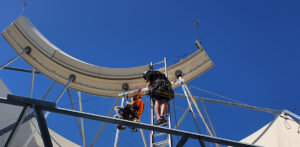Here is a collection of questions our team are commonly asked about static line safety systems.
Static lines are a common type of fall protection system that can be installed on a variety of different roof types and materials.
This versatility in use often means people can have many questions about how these systems work, what can be done using them and why a static line is proposed over another type of fall protection.
Our team has compiled some of the most common static line questions they have received into this handy FAQ.
Can I abseil off a static line? Can I use a static line as an anchorage for rope access?
No, you cannot abseil off a static line or use one for rope access.
While static lines are design to allow a worker to move freely while remaining in fall restraint, the system is not designed to support the loads required for abseil or rope access work.
Static lines are a fall protection system only.
Can I use static lines to lift loads onto a roof?
No.
The reason for this is the same as why a static line cannot be used for abseiling or rope access work. The system is not designed to support the sustained loads of lifting materials onto a roof.
Static line systems are used for worker fall protection only. Once a system receives a load through it that is enough to deploy in-built shock absorbers, the system will be non-compliant until it is repaired or replaced.
What are the differences between static lines and a rigid rail system?
A static line system is a length of tensioned, stainless-steel cable strung between two points. A worker attaches a shuttle to their harness which allows them to walk along the length of the while remaining in fall restraint.
By comparison, while a rigid rail system works in a similar manner, instead of a steel cable the system is built using a fixed metal track.
Most rigid rail systems can be used for rope access or abseil work, while static lines cannot.
Can I just connect a carabiner or lanyard to a static line?
Sort of, but not really.
While connecting to a static line without a shuttle is possible, it is going to significantly limit the usefulness of the system.
The biggest practical issue that will be encountered is that a lanyard with a scaffold hook or carabiner will not be able to pass through any intermediate points on the static line. This means that a worker would require a twin-tail lanyard to disconnect and reconnect at every interval. This potentially places them at risk of a fall while not connected to the system.
More pointedly, however, the operations and usage manuals for static line systems will often prescribe that they only be used with a shuttle provided by the manufacturer of the line. Not using this device means the worker is not using the system as in compliance with correct procedures.
Can I use a shuttle from Manufacturer B on static lines built using components from Manufacturer A?
No.
Manufacturers of static line systems state in the manuals that only their shuttles are to be used on these systems.
Much like the previous question, there is a practical problem in that shuttles are designed to go with the fittings of their manufacturer’s static line systems.
The most frequently installed static line systems use the same 8mm diameter steel cable, meaning it is very likely that different brands of shuttles can be attached to different brands of static line system. However, the intermediate anchorage points and corner points are designed slightly differently between manufacturers.
What a worker may discover, if using a different manufacturer’s shuttle, is that movement along the line is difficult as the shuttle does not move freely across the intermediate points or around corners.
And again, like the previous question, the manual for the system from the manufacturer will specify that only their shuttles are compliant to be used on the installed line. While using a different shuttle may physically work, in the event of an accident it could be determined that the worker was not using the system correctly.
Understanding your safety responsibility
Height Safety Engineers work across a range of industries and different high-risk environments to assist employers and building owners in addressing their height safety needs.
Start your safety journey with our experts by calling 1300 884 978 or email enquiries@heightsafety.net.





